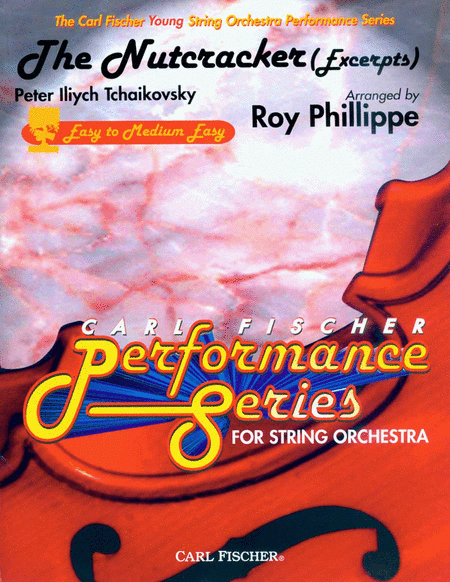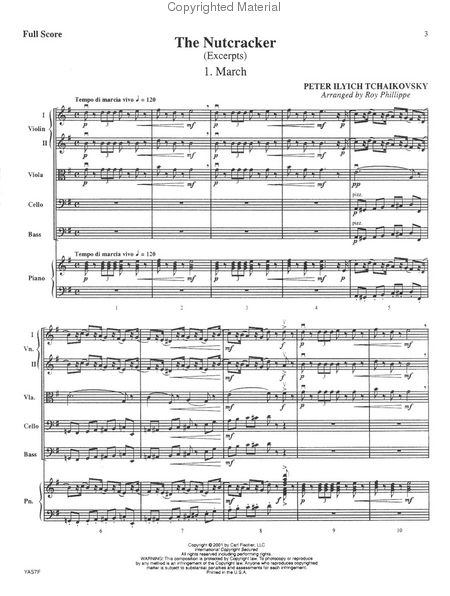The Nutcracker (Excerpts)
Full Score and Parts
Order On Demand
-
Ships in 1 to 2 weeks
See more offers for this item
Details
Ensembles
Genres
Composers
Arrangers
Publishers
Formats
Item Types
Editions
Levels
Usages
Description
Orchestra String Orchestra - Grade 2-2.5
March This movement should give the impression of toy soldiers on the move. Careful attention should be paid to all articulations and dynamics, especially the crescendo from p to mf to f. Dance of the Sugarplum Fairy In the original orchestration, this familiar melody is scored for celeste. In performing this arrangement try to keep that light texture in mind. This can be achieved by observing all dynamics and articulations. The detache bowing in the violins contribute to the gentle nature of this movement. Trepak Again, dynamics are of primary importance and contrasts occur frequently throughout. For example, m. 1 begins with an accented f dynamic on the first beat, then immediately drops to p on the second beat. In mm. 33 through 42 the melody is played by the violas and cellos and should be emphasized. Beginning in m.47 the violas are playing a countermelody in half notes. Even though the notes are accented, the melody in the violins should predominate.
MarchThis movement should give the impression of toy soldiers on the move. Careful attention should be paid to all articulations and dynamics, especially the crescendo from p to mf to f. Dance of the Sugarplum FairyIn the original orchestration, this familiar melody is scored for celeste. In performing this arrangement try to keep that light texture in mind. This can be achieved by observing all dynamics and articulations. The detache bowing in the violins contribute to the gentle nature of this movement. TrepakAgain, dynamics are of primary importance and contrasts occur frequently throughout. For example, m. 1 begins with an accented f dynamic on the first beat, then immediately drops to p on the second beat. In mm. 33 through 42 the melody is played by the violas and cellos and should be emphasized. Beginning in m.47 the violas are playing a countermelody in half notes. Even though the notes are accented, the melody in the violins should predominate.
SKU: CF.YAS7
Full Score and Parts. Composed by Peter Ilyich Tchaikovsky. Arranged by Roy Phillippe. FS-SWS. Carl Fischer Young String Orchestra Series. Score and Parts. With Standard notation. 24+6+6+15+15+7+15+16 pages. Carl Fischer Music #YAS7. Published by Carl Fischer Music (CF.YAS7).ISBN 9780825845390. UPC: 798408045395. 8.5 X 11 inches. Key: G major.
- March This movement should give the impression of toy soldiers on the move. Careful attention should be paid to all articulations and dynamics, especially the crescendo from p to mf to f.
- Dance of the Sugarplum Fairy In the original orchestration, this familiar melody is scored for celeste. In performing this arrangement try to keep that light texture in mind. This can be achieved by observing all dynamics and articulations. The detache bowing in the violins contribute to the gentle nature of this movement.
- Trepak Again, dynamics are of primary importance and contrasts occur frequently throughout. For example, m. 1 begins with an accented f dynamic on the first beat, then immediately drops to p on the second beat. In mm. 33 through 42 the melody is played by the violas and cellos and should be emphasized. Beginning in m.47 the violas are playing a countermelody in half notes. Even though the notes are accented, the melody in the violins should predominate.
- March This movement should give the impression of toy soldiers on the move. Careful attention should be paid to all articulations and dynamics, especially theA crescendo fromA p toA mf toA f.
- Dance of the Sugarplum Fairy In the original orchestration, this familiar melody is scored for celeste. In performing this arrangement try to keep that light texture in mind. This can be achieved by observing all dynamics and articulations. TheA detache bowing in the violins contribute to the gentle nature of this movement.
- Trepak Again, dynamics are of primary importance and contrasts occur frequently throughout. For example, m. 1 begins with an accentedA f dynamic on the first beat, then immediately drops toA p on the second beat. In mm. 33 through 42 the melody is played by the violas and cellos and should be emphasized. Beginning in m.47 the violas are playing a countermelody in half notes. Even though the notes are accented, the melody in the violins should predominate.
March This movement should give the impression of toy soldiers on the move. Careful attention should be paid to all articulations and dynamics, especially the crescendo from p to mf to f. Dance of the Sugarplum Fairy In the original orchestration, this familiar melody is scored for celeste. In performing this arrangement try to keep that light texture in mind. This can be achieved by observing all dynamics and articulations. The detache bowing in the violins contribute to the gentle nature of this movement. Trepak Again, dynamics are of primary importance and contrasts occur frequently throughout. For example, m. 1 begins with an accented f dynamic on the first beat, then immediately drops to p on the second beat. In mm. 33 through 42 the melody is played by the violas and cellos and should be emphasized. Beginning in m.47 the violas are playing a countermelody in half notes. Even though the notes are accented, the melody in the violins should predominate.
MarchThis movement should give the impression of toy soldiers on the move. Careful attention should be paid to all articulations and dynamics, especially the crescendo from p to mf to f. Dance of the Sugarplum FairyIn the original orchestration, this familiar melody is scored for celeste. In performing this arrangement try to keep that light texture in mind. This can be achieved by observing all dynamics and articulations. The detache bowing in the violins contribute to the gentle nature of this movement. TrepakAgain, dynamics are of primary importance and contrasts occur frequently throughout. For example, m. 1 begins with an accented f dynamic on the first beat, then immediately drops to p on the second beat. In mm. 33 through 42 the melody is played by the violas and cellos and should be emphasized. Beginning in m.47 the violas are playing a countermelody in half notes. Even though the notes are accented, the melody in the violins should predominate.
About Carl Fischer Young String Orchestra Series
This series of Grade 2/Grade 2.5 pieces is designed for second and third year ensembles. The pieces in this series are characterized by:
--Occasionally extending to third position
--Keys carefully considered for appropriate difficulty
--Addition of separate 2nd violin and viola parts
--Viola T.C. part included
--Increase in independence of parts over beginning levels
Song List (3)
- 1. March
- 2. Dance of the Sugar Plum Fairy
- 3. Trepak


 Share
Share